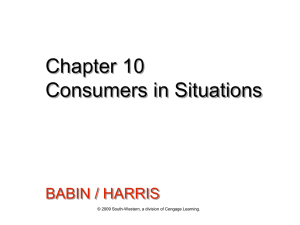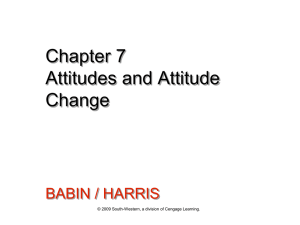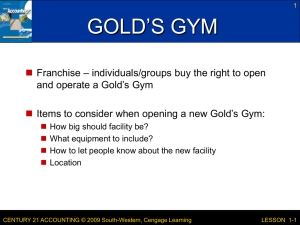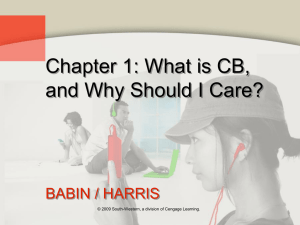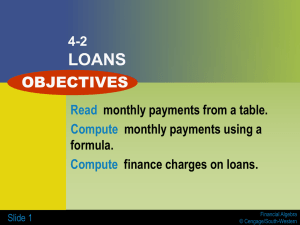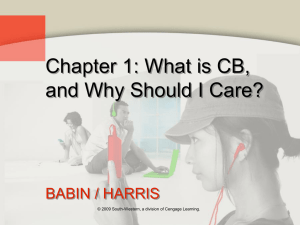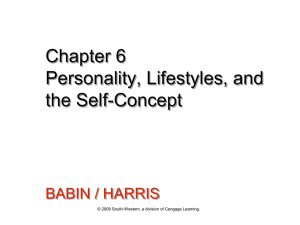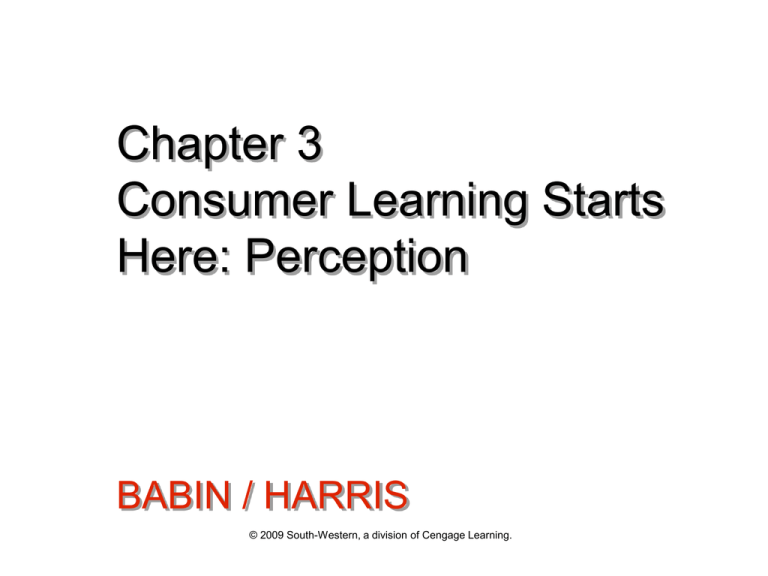
Chapter 3
Consumer Learning Starts
Here: Perception
BABIN / HARRIS
© 2009 South-Western, a division of Cengage Learning.
Learning Outcomes
LO1
Define perception and understand the
elements of consumer perception
(exposure, attention, and interpretation).
LO2
Understand the concept of perceptual
defenses – consumers are selective!
LO3
Be able to apply the concept of the JND.
© 2009 South-Western, a division of Cengage Learning.
3-2
Learning Outcomes
LO4
Know the ways in which a consumer’s
attention can be enhanced.
LO5
Understand how learning theories are
applied to CB
© 2009 South-Western, a division of Cengage Learning.
3-3
LO1
Understand the elements of
consumer perception.
© 2009 South-Western, a division of Cengage Learning.
LO1
Learning and Perception
• Learning – a change in the content of
long-term memory or behavior resulting
from the interaction between a person and
a stimulus.
• Perception – a consumer’s awareness
and interpretation of reality.
– Value involves learning, and consumer learning
begins with perception.
– Perception involves a stimulus and response.
© 2009 South-Western, a division of Cengage Learning.
3-5
LO1 Elements of Consumer Perception
Exposure
Attention
Interpretation/
Comprehension
© 2009 South-Western, a division of Cengage Learning.
3-6
LO1
Exposure
Exposure occurs when a stimulus is placed within a
person’s relevant environment and comes within
range of their five senses.
Exposure
provides the
opportunity to
pay attention
to available
information
but in no way
guarantees it.
© 2009 South-Western, a division of Cengage Learning.
3-7
LO1
Attention
Attention requires
consumers to allocate
limited mental
resources toward the
processing of
incoming stimuli such
as packages on store
shelves or advertising.
© 2009 South-Western, a division of Cengage Learning.
3-8
LO1
Interpretation/Comprehension
Interpretation or comprehension is the
assignment of meaning to the information
you receive from your five senses.
• Based on your past experiences
• Tends to be consistent with your
expectations
• You can interpret cognitively or
affectively
© 2009 South-Western, a division of Cengage Learning.
3-9
LO2
Perceptual Defenses:
Selective Perception
Selective exposure
Selective attention
Selective distortion
© 2009 South-Western, a division of Cengage Learning.
3-10
LO2
Must We Pay Attention?!
Is this subliminal stuff true?
© 2009 South-Western, a division of Cengage Learning.
3-11
LO2 Disney Sneaking Subliminal Messages
to Kids? The Rescuers – Objectionable Background
Image?!
© 2009 South-Western, a division of Cengage Learning.
3-12
LO2 Disney Sneaking Subliminal Messages
to Kids? Lion King – Sex in the Stars?!
© 2009 South-Western, a division of Cengage Learning.
3-13
LO2
Subliminal Groovin!
Can you play a record
backwards – or is it just
another subliminal rumor?
© 2009 South-Western, a division of Cengage Learning.
3-14
LO3
Be able to apply the concept of
JND.
© 2009 South-Western, a division of Cengage Learning.
LO3
JND
(Just Noticeable Difference)
• Represents how much stronger one
stimulus has to be relative to another
so that someone can notice that the
two are not the same.
• Examples:
– Small price increases
– Small quantity decreases
– The movie Fight Club
© 2009 South-Western, a division of Cengage Learning.
3-16
LO4
Know the ways in which a
consumer’s attention can be
enhanced.
© 2009 South-Western, a division of Cengage Learning.
LO4
Attracting Attention
How are your
going to get
her attention?
© 2009 South-Western, a division of Cengage Learning.
3-18
LO4
Ways to Enhance Attention
Intensity
Contrast & Isolation
Color & Movement
Surprise
Size
Similarity
Attractive
Involvement
© 2009 South-Western, a division of Cengage Learning.
3-19
LO4
Ways to Enhance Attention
This ad uses:
Contrast & Isolation
Intensity
Color & Movement
Size
3-20
LO4
Ways to Enhance Attention
Here, color not
only serves to
attract attention,
its also being used
as a product
benefit!
3-21
LO4
Ways to Enhance Attention
A great
example of
contrast…
3-22
LO4
Ways to Enhance Attention
An ad that is
surprising –
goes against
expectations
– can be very
effective at
grabbing
attention
3-23
LO4
Ways to Enhance Attention
Another great example of surprise –
certainly goes against expectations
3-24
LO5
Understand how learning
theories are applied to CB
© 2009 South-Western, a division of Cengage Learning.
LO5
Intentional vs. Unintentional
Learning
Intentional learning
(HIGH involvement)
Consumers set out to
specifically learn
information devoted to a
certain subject.
Unintentional learning
(LOW involvement)
Consumers simply sense
and react (or respond) to
the environment.
3-26
LO5
Learning Theories
Behaviorism – for low involvement
learning; states that learning should be
based on stimulus and response
Information Processing, or cognitive
learning – for high involvement
situations; based on deeper
comprehension of material
© 2009 South-Western, a division of Cengage Learning.
3-27
LO5
Behaviorism Example
This is a lowinvolvement learning
situation.
The imagery and
feeling triggered by
the ad may become
associated with the
prominently
displayed brand
name.
3-28
LO5 Classical Conditioning – An Example
of Behaviorism
A change in behavior
that occurs simply
through associating
some stimulus with
another stimulus that
naturally causes a
reaction.
© 2009 South-Western, a division of Cengage Learning.
3-29
LO5 Classical Conditioning – The Classic
Example!
UCS
(dog food)
UCR
(dog drool)
CS
(ringing bell)
CR
(dog drool)
UCS = Unconditioned stimulus
CS = Conditioned stimulus
UCR = Unconditioned response
CR = Conditioned response
3-30
LO5 Consumer Learning Through Classical
Conditioning
UCS
(popular music)
UCR
(happy emotion)
CS
(Burger King)
CR
(happy emotion)
UCS = Unconditioned stimulus
CS = Conditioned stimulus
UCR = Unconditioned response
CR = Conditioned response
3-31
LO5
Instrumental Conditioning
Behavior is
conditioned through
reinforcement.
© 2009 South-Western, a division of Cengage Learning.
3-32
LO5 Instrumental Conditioning Example
Stimulus
(free sample of
Rice Popcorn)
Desired response
(consumption)
Reinforcement
(pleasant taste)
Increases probability
of response to stimulus
3-33


